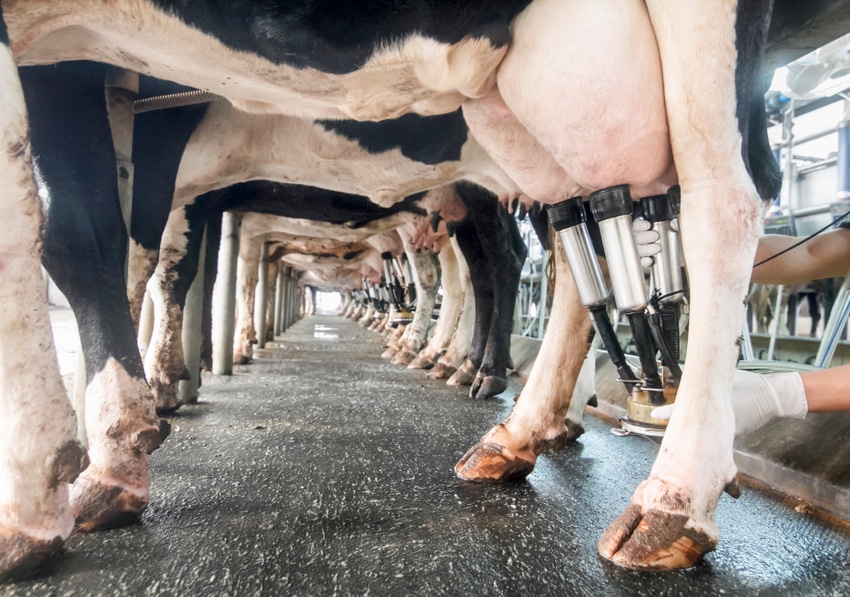Dairy sector forecast calls for stabilization
Margins to improve due to lower feed prices and dairy product price support.

U.S. milk production is expected to continue to keep growing in 2024, but at a slower rate than what has been seen in recent years, Mike McConnell, agriculture economist with the U.S. Department of Agriculture, said during the dairy outlook session at the 2024 USDA Agricultural Outlook Forum.
Feed prices overall are expected to be lower, which should improve dairy producer margins. Additionally, tighter global markets for dairy products will provide price support and create a more competitive marketplace.
USDA expects cow inventories to stabilize in 2024. McConnell said levels are projected to be lower in 2024 than they were last year but flat for most of the year. However, a small uptick is expected in the fourth quarter as prices and margins improve.
Meanwhile, prices for cull cows remain strong because of the tight beef supplies. Improving milk values, however, should provide support for dairy producers to maintain their current herd levels, McConnell said.
Milk output growth slowing
Milk output is growing, although at a slower rate, and a long-term flattening trend is forecast, according to McConnell. In the past, U.S. milk output growth has been around the 1.5-2.0% range but now it is more likely to be around 1.0%, he added.
Even though milk output growth is slowing relative to the past, McConnell said this doesn’t necessarily mean overall productivity is on the decline. “Over the past decade, milk has produced a much higher rate of components in a pound of milk.”
When this is combined with milk output per cow, milk fat produced per cow is not really slowing down at all. “So, while we may be seeing a slowdown in production growth, we’re still seeing consistent growth in the production of components that are so important to dairy production,” he noted.
With stabilizing inventories, higher milk per cow, and the extra leap year day, USDA is forecasting a 0.7% year-over-year increase in milk production in 2024. This still leads to relatively tight milk supplies as about half of the growth is due to the extra milking day, McConnell said.
Lower exports in 2024
Global exporters are expected to ship less product in 2024, according to the outlook. Both the European Union and New Zealand are projecting less milk production, which McConnell said translates into lower dairy product exports. Demand for dairy product imports from major importing countries is expected to increase. Fewer exports, less milk production and consumption growth means relatively tighter markets for dairy products in 2024. This should be supportive of prices, McConnell said.
U.S. dairy product prices have remained fairly competitive despite the recent higher prices in 2023. This is particularly notable for butter, where strong seasonal spikes have occurred heading into the winter holiday season for the past two years in a row. Cheese prices have also been competitive, in part due to the increased production capacity built in the U.S. over the past 5-10 years.
The overall story, McConnell relayed, is that even though U.S. prices have risen a little from the recent lows in the past year, international prices are coming up to meet U.S. prices rather than pulling them down.
Whey prices have steeply declined, primarily due to weaker international demand. However, this has spurred domestic demand. The question for 2024 is how the competition between domestic and international whey demand will shake out, McConnell said.
The bottom line is that both domestic and international dairy demand is expected to be robust this year.
Butter and nonfat dry milk prices are expected to be higher, while cheese prices are expected to fall, although McConnell said they’ll be higher than prices in the past couple months.
All of these factors mean higher class prices, leading USDA to forecast the 2024 all-milk price at $20.95/lb., up from $20.48/cwt. in 2023 but not necessarily as high as prices in 2022.
“These prices, combined with lower feed costs, would result in better margins and improved feed ratios broadly. However, both the financial returns and the constraints of the structure of the herd are likely to support the outlook of a stabilizing market rather than any strong expansionary signals,” McConnell concluded.
About the Author(s)
You May Also Like





